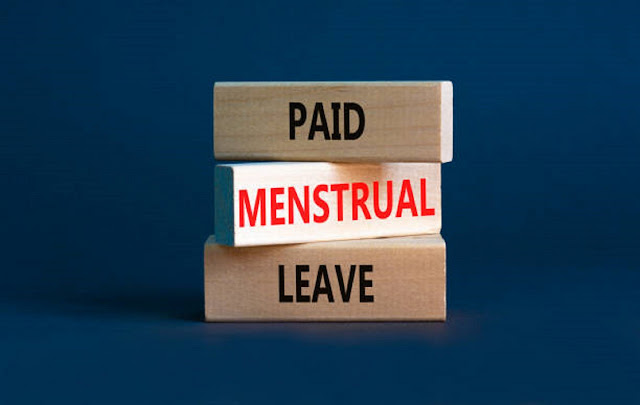The issue of menstrual leave has been on everyone's lips for
some time, but it has gained new momentum with the Spanish government's
proposal to allow women to take time off work in the event of severe uterine
symptoms. If approved, Spain would be the first nation in all of Europe to
provide regular paid leave on a national level.
South Korea, Taiwan, and Zambia offer one day of unpaid
menstrual leave per month, while Indonesia offers two days of paid menstrual
leave. However, there is currently no menstrual leave law in the United States.
There are, of course, paid and unpaid menstrual leaves. Why
isn't this more frequent, one wonders? The solution is not as straightforward
as you may expect. In order to answer this issue, we must first examine how
this policy came to be.
What Is Period Leave?
Menstrual leave is a period of paid absence from work for
individuals who are menstruating in utero due to symptoms that affect their
work performance. Historically, menstrual leave has been closely linked to
debates about women's health, productivity, and gender equality.
History of Menstrual Vacation
Although menstrual leave may seem like a recent and
progressive idea, it has actually been around for quite some time. Menstruating
women have been protected by the law since the 1920s and 1930s in Soviet
Russia. During the same period, the law became popular with trade unions in
Japan and finally went into effect in 1947, allowing women to take monthly
menstrual leave.
In 1912, a school in the Indian state of Kerala allowed
girls to take time off during annual exams due to menstrual cramps.
At the time, the menstrual leave policy tended to be
justified by poor working conditions leading to infertility. More recently, the
focus has shifted to the overall health of the worker and the impact of
menstrual cramps on her ability to work.
Positive Side of Paid Period Leave
Menstruating women, trans males, and non-binary people have
the most potential to benefit from the successful implementation of menstrual
leave. It is estimated that 80% of all menstruating people experience menstrual
cramps at some point in their lives, but the symptoms are not limited to that.
Menstruation can also cause back pain, stiff shoulders, dizziness, headaches, and fatigue.
These symptoms can hinder some people's ability to work
productively. Being able to take time out of work without it having an
impact on your pay is consequently quite useful. More severe symptoms, like
those mentioned above, can also be brought on by chronic menstruation issues
such as endometriosis, polycystic ovarian syndrome, and premenstrual dysphoric
disorder.
Talk about menstruation can become more commonplace with the
implementation of paid leave. Menstruation continues to carry a significant
social stigma that manifests early in life. Menstruation should be kept
private, think 37% of boys in Brazil, Indonesia, the Netherlands, and Uganda,
and 55% of them regard it as "filthy," according to a new Plan
International study. Even among adults, these opinions are common in the
workplace.
The stigma of menstruation in the workplace is real, and
paid menstrual leave may help increase the frequency of these conversations. If
no one turns a blind eye when a co-worker has a cold, why should similar or
more serious complaints about menstruation be treated differently?
Objections to Paid Menstrual Leave
While there is no doubt that paid menstrual leave can be
very beneficial to menstruate workers, some argue that the introduction of
such a policy can be detrimental to those it is intended to protect.
For example, paid menstrual leave, if improperly
implemented, can increase the risk of discrimination in the workplace by both
employers and co-workers. As mentioned earlier, the stigma of menstruation is
widespread in the workplace. Thus, labeling some form of sick leave as
menstruation could reinforce gender stereotypes by creating the assumption that
biological women are not good at their jobs.
In terms of employment, these policies may lead employers to
prioritize candidates who do not opt for menstrual leave.
This can also lead to confidentiality issues. If you are
required to disclose that you are on menstrual leave, you may be uncomfortable
with your manager knowing your menstrual cycle. It also allows managers to
infer employee performance from conditions such as premenstrual syndrome (PMS).
In addition, these measures may force transgender people to
reveal their identity before they are ready or comfortable. According to a
study published by McKinsey, more than half of transgender people in the United
States do not feel comfortable in the workplace, and transgender people are
twice as likely to lose their jobs as same-sex adults.
Finally, some may argue that leave policies for certain
periods do not benefit and alienate gay people. Some employees with pre-existing
conditions unrelated to menstruation may also feel marginalized.
Is There a Middle Ground?
In the absence of a national policy, the decision to
implement paid menstrual leave is ultimately up to the employer.
While the issue is certainly controversial, a potentially
effective solution to prevent menstruating workers from being discriminated
against and non-menstruating workers from feeling excluded would be to extend
short-term sick leave to all workers without requiring disclosure of the
reasons for taking it.
This would allow workers to take paid leave for personal and
medical reasons, such as mental or chronic illness, as well as for menstrual
periods. It would also protect workers' right to privacy at work.




